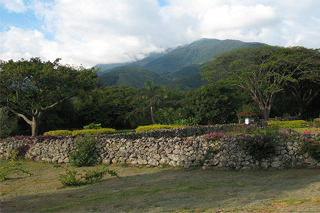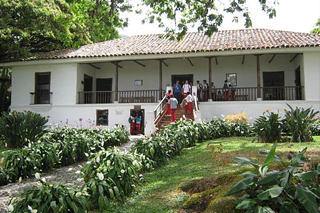Just an hour from Cali (36 km) lies one of the favorite destinations of foreign tourists who visit the department of Valle del Cauca. Hacienda El Paraíso, today a house museum, is the icon of this Colombian region and is known worldwide as the stage for the epitome of Latin American romantic novel: María, by Jorge Isaacs.
Hacienda El Paraíso as the stage for María
The Hacienda Paraíso House Museum is imbued with the novel by Jorge Isaacs.
The experience of visiting it leaves a pleasant memory of a guided tour in which the mentioning of fragments of María captivates the readers from various countries.
This is how Efraín, the novel’s main character, describes the landscape and Hacienda El Paraíso:
I was speechless before so much beauty. […] Thus the sky, the horizons, the pampas and the peaks of Cauca render silent those who contemplate them. […] Before the sun set, I had seen the house of my parents turn white on the skirt of the mountain. As I got closer, with an anxious gaze, I counted the groups of willows and orange trees, through which a short while later I saw the lights of the rooms crossing. […] At last, I breathed that never forgotten smell of the orchard. […] The shoes of my horse sparkled on the cobblestones of the patio. […] At eight, we went to the dining room, which was picturesquely located in the eastern part of the house. From there, the naked crests of the mountain could be seen against the star-decked background of the sky. The auras of the desert strolled through the garden gathering aromas to come frolicking with the rosebushes that surrounded us. The fickle wind briefly allowed listening to the whispers of the river.
Hacienda El Paraíso was declared a National Monument in 1959.
The scenery in Valle del Cauca
The landscape in Valle del Cauca is covered by sugar cane plantations. The hacienda, its nearby mountains, the rivers, the leafy trees, the warm, pleasant climate, and the incredible freshness of the air turn this spot into a destination to which visitors return over and over again.
A bit of hacienda history
The house was built between 1816 and 1828 by Víctor Cabal, a cattleman from Buga and former mayor of the city of Cali. Jorge Isaacs’s father bought it in 1828. Most of the María novel takes place there. The Department of Valle del Cauca bought it in 1953, and a few years later, on December 30, 1959, it was declared a National Monument.

Hacienda El Paraíso
Photo by: Ben Bowes
Architecture of the house
Hacienda El Paraíso is an excellent example of the traditional architecture of large houses with high ceilings typical of the large estates of the Valle del Cauca region.
Located at the foothills of the Western Range of the Andes, the hacienda offers a precious view of green plains adorned by extensive sugar cane plantations and gigantic saman trees.
The entire building is surrounded by water canals built to avoid the passage of insects and snakes and to guarantee freshness inside. Additionally, the house has cool balconies and is surrounded by leafy vegetation. From the entrance of the Hacienda to the stairs, there is a precious garden in which, according to the novel, María picked the freshest flowers for her beloved Efraín every morning.
Another witness to the love of Efraín and María is an immense rock, also described in the book, located in the front part of the hacienda.
Rooms of the house
History, nature, romanticism, and roses in a thousand colors are some of the elements that make up Hacienda El Paraíso.
The Hacienda preserves the floor plan described in the novel. It consists of the following rooms, surrounded by the typical balconies of the Valle del Cauca region.
Efraín’s room:
which contains the trunk he took on his travels and the vase in which fresh roses are placed daily in remembrance of the flowers María brought to her beloved’s room every morning.
The study:
where Efraín gave literature and geography lessons to María and to his sisters, Emma and Eloísa.
The living room:
where the family got together to chat and the women did embroidery and sang in the afternoon.
The room of Efraín’s sisters
Emma and Eloísa.
Efraín’s mother´s room:
with the beds of his sisters and brothers.
María’s room:
located beside Efraín’s mother’s room, with a lovely view to the garden.
Efraín’s father’s study:
where household decisions were taken.
The dining room:
with a gigantic table at which the whole family met.
The oratory:
where every Sunday the priest arrived to say three masses in Latin: one for family members, another one for people close to the family, and the last one for the slaves. These masses were held with the priest’s back to the participants, as was usual at the time.
The kitchen
a very important part of the house, with authentic period pieces.
The inner patio:
with a precious rose garden.

Hacienda El Paraíso
Photo by: Luciablu91
To arrive at Hacienda El Paraíso is to encounter a monument that exudes a history of romantic love, is to see María's photograph, the clock that signals the time of her death, and a fresh rose in a vase in Efraín's room, which in spite of María's absence, remains there as a memento to sensitize the hearts of visitors.
Hacienda surroundings
The Hacienda covers an area of 120 hectares where, aside from the House Museum, there is a souvenir shop, a cafeteria, a parking lot, and the Hostal Piedemonte. This is a hostel with 26 cozy chalets, pools of natural running water, a restaurant with the region’s typical cuisine, horse rental, greens zones, and spaces for events such as weddings.
Visitor Information
Visiting hours:
Hacienda El Paraíso opens its doors to visitors from Tuesday to Sunday between 9:30 am and 4:30 pm. The Hacienda is closed on Tuesdays that follow a Monday holiday.
Tickets:
Adults $ 8.000 pesos (2.46 USD)
Children (to age 12) $ 5.000 pesos (1.54 USD)


















